#learn about evolution
Explore tagged Tumblr posts
Text
i want to put more monster hunters in other school verse.. for Flavor
#ungodly screeching#ocs#i imagine being a monster hunter in a school attended by a lot of monsters/inhuman beings is kinda like#those kids whose parents are one wrong move from homeschooling them and make the school excuse them from science class so they dont#learn about evolution#theres probably not a lot of monster hunter kids in the other school for that reason like traditional education is probs considered secondar#to like learning to fire a crossbow and stuff#hunter homeschool networks... yea i can see it#still i crave the Conflict
13 notes
·
View notes
Text
Chronostorm Adventure: The Ice Age Gambit
written by AI and edited by a human 16/01/2025
Chronostorm Adventure: The Ice Age Gambit
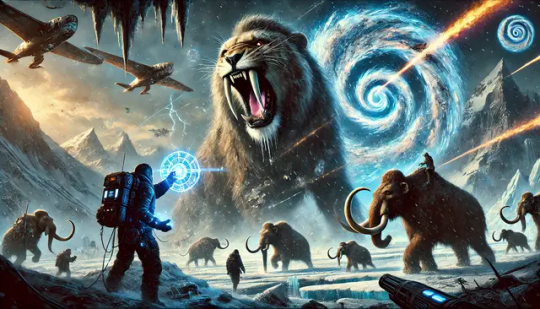
The Iceage chronostorm with a couple of lost WWII planes, but that is a different story
Hitchhiker’s Guide Disclaimer for Chronostorm Adventure: The Ice Age Gambit
Warning: The events described in this narrative are a work of fiction. Any resemblance to actual people, places, temporal anomalies, or genetic interferences—past, present, or future—is purely coincidental and absolutely unintentional. Unless, of course, you happen to be a time-traveling anthropologist, in which case, let’s talk.
Time Travel Advisory: Do not attempt to recreate or interfere with historical epochs, especially the Pleistocene. The Ice Age is notoriously unforgiving, featuring hostile climates, dangerous megafauna, and a distinct lack of Wi-Fi. Any temporal excursions may result in paradoxes, unexpected interspecies encounters, and possible erasure from the space-time continuum. Consult your local Chrono-Authority for guidelines.
Genealogical Notes: While the importance of the EPAS1 gene and interbreeding between Homo sapiens, Neanderthals, and Denisovans is grounded in scientific research, the existence of swirling temporal storms and glowing stabilization devices is, at best, speculative. Please do not petition your geneticist for high-altitude adaptations based on this story.
Chrono-ethics Clause: Any tampering with the migratory patterns of early Homo sapiens or their genetic contributions may result in catastrophic changes to the present. Proceed with caution, and remember: It’s all fun and games until someone destabilizes the evolutionary timeline.
Final Reminder: Don’t Panic. Whether you’re traversing glaciers, navigating prehistoric social dynamics, or avoiding a saber-toothed cat, keep a towel handy and your Temporal Environmental Stabilizer charged. And always, always follow the rules of time travel—even if your AI says otherwise.
Now sit back, relax, and enjoy Chronostorm Adventure: The Ice Age Gambit. And remember: History is only safe when left undisturbed (most of the time).
The team’s decision to jump into the Ice Age was driven by an urgent call to action. A Chronostorm had been detected in the Pleistocene epoch, its epicenter located along a critical migratory path for early Homo sapiens and their interactions with Denisovans. The storm’s destabilizing effects threatened to isolate populations, erase genetic legacies, and collapse the evolutionary timeline of modern humans.
The Mission Brief
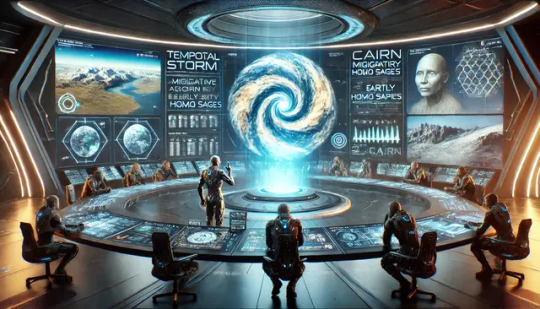
the mission briefing room where the team prepares for their journey into the Ice Age
“Without intervention,” Cairn, the team’s AI, explained during the mission briefing, “this anomaly could prevent essential genetic exchanges that shaped the adaptive traits of Homo sapiens, such as the EPAS1 gene inherited from Denisovans. This gene is crucial for enabling survival in high-altitude, low-oxygen environments by regulating red blood cell production. Its loss could have cascading effects on human adaptability and evolution, as highlighted by research such as Huerta-Sánchez et al. (2014).”
Anika, the mission lead, had reviewed the historical and genetic consequences. “If we lose those contributions, humanity’s ability to survive in extreme conditions could vanish,” she had concluded.
A Harsh Landscape
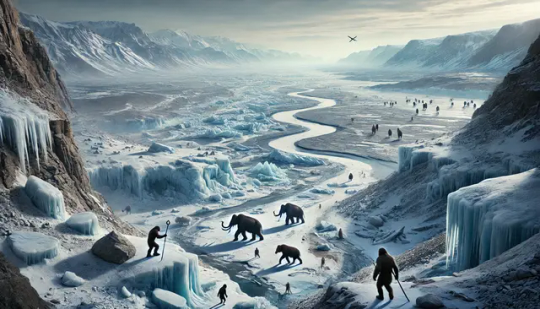
The frozen expanse of the Pleistocene epoch stretched endlessly, a stark and unforgiving landscape dominated by glacial ice and treacherous tundra. The extreme conditions not only shaped the evolutionary pressures faced by early humans but also posed significant challenges to the team's mission, forcing them to navigate unstable terrain while stabilizing the temporal storm. Spanning from about 2.6 million to 11,700 years ago, the Pleistocene epoch was characterized by repeated glacial cycles and significant climatic fluctuations. It was a time of evolutionary pressures that shaped the survival of megafauna and early humans alike.
The Evolutionary Context
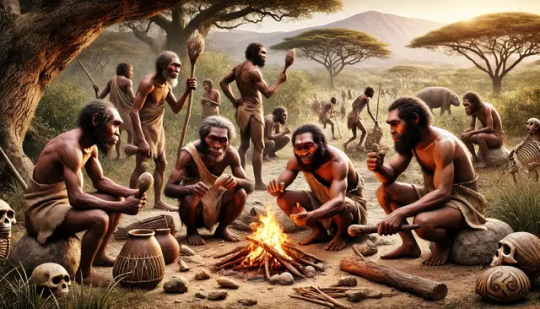
evolution of Homo sapiens in Africa approximately 300,000 years ago
The evolution of Homo sapiens began approximately 300,000 years ago in Africa. Fossil evidence and genetic studies reveal that early Homo sapiens exhibited a blend of archaic and modern features, including a large brain capacity that enabled advanced cognitive functions such as abstract thought, problem-solving, and symbolic communication. These traits distinguished them from other hominins and contributed to their adaptability in diverse environments. Over tens of thousands of years, Homo sapiens developed tools, mastered fire, and established complex social structures. By around 70,000 years ago, a significant migratory wave saw them spreading across the globe, interacting with and, in some cases, interbreeding with Neanderthals and Denisovans. This genetic exchange enriched the diversity of Homo sapiens and enhanced their ability to survive in various climates.
The Neanderthals and Denisovans

The Neanderthals, who evolved roughly 400,000 years ago, primarily in Europe and parts of Asia, were another remarkable branch of the human evolutionary tree. Adapting to colder climates during the Ice Age, Neanderthals developed stocky builds, large nasal passages to warm the air they breathed, and robust physical strength to endure harsh conditions. Their cognitive capabilities were advanced, evidenced by their use of complex tools, fire management, and possibly even language. They also demonstrated cultural sophistication, engaging in burial practices and creating symbolic art. Despite their adaptability, Neanderthals began to decline around 40,000 years ago, likely due to a combination of climate shifts, competition with Homo sapiens, and assimilation through interbreeding.

Denisovans, a contemporaneous group with Neanderthals, inhabited parts of Asia and contributed significantly to the genetic legacy of modern humans, especially in populations of Southeast Asia, Oceania, and Tibet. Discovered from remains in Siberia’s Denisova Cave, their genetic contributions are particularly notable in adaptations for high-altitude survival, such as the EPAS1 gene found in modern Tibetans. This gene allows efficient oxygen usage in low-oxygen environments by regulating red blood cell production. Without Denisovan contributions, human expansion into extreme high-altitude regions might not have been possible.
Megafauna of the Ice Age
The megafauna of the Pleistocene were among the most iconic creatures in Earth's history. These large animals included the woolly mammoth, saber-toothed cats, giant ground sloths, and the short-faced bear:
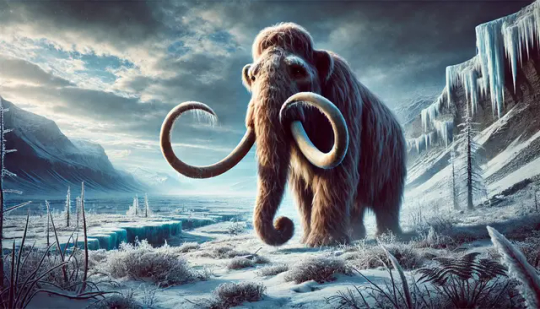
The Woolly Mammoth: Ice Age Icon
The woolly mammoth (Mammuthus primigenius), one of the most recognizable creatures of the Ice Age, was a massive herbivore perfectly adapted to the harsh, frozen landscapes of Eurasia and North America. Standing up to 13 feet tall at the shoulder and weighing as much as 6 tons, these gentle giants were covered in thick, shaggy fur with a dense undercoat to insulate them from frigid temperatures.
Their long, curved tusks, which could grow up to 15 feet in length, were used for digging through snow to uncover vegetation, fending off predators, and competing with other mammoths. Woolly mammoths thrived on a diet of grasses, shrubs, and other tough Ice Age plants, consuming hundreds of pounds of food daily to sustain their massive size.
Living in herds, woolly mammoths displayed social behaviors similar to modern elephants, with strong familial bonds and complex communication. They played a critical role in shaping their ecosystems by grazing and dispersing seeds.
Despite their resilience, woolly mammoths faced extinction around 4,000 years ago, likely due to a combination of climate change and overhunting by humans. Their legacy endures through well-preserved fossils and frozen specimens, offering scientists invaluable insights into life during the Ice Age.
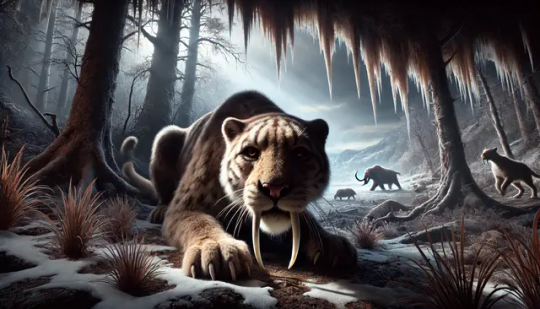
The Saber-Toothed Tiger: Apex Predator of the Ice Age
The saber-toothed tiger (Smilodon), one of the most iconic predators of the Ice Age, was a fearsome carnivore known for its elongated canine teeth, which could grow up to 7 inches long. Despite its name, Smilodon was not closely related to modern tigers but belonged to a distinct lineage of prehistoric cats.
Weighing up to 600 pounds and equipped with powerful forelimbs, Smilodon was built for strength rather than speed. It likely used ambush tactics to take down large prey, such as mammoths, bison, and ground sloths. Once it immobilized its prey, its saber-like teeth delivered precise, lethal bites to the throat or neck.
These formidable predators thrived in the Americas, from grasslands to forests, adapting to a variety of environments during the Pleistocene epoch. However, Smilodon became extinct around 10,000 years ago, likely due to the decline of large prey and environmental changes at the end of the Ice Age.
Today, Smilodon remains a symbol of Ice Age megafauna, embodying both the raw power and evolutionary ingenuity of a bygone era.
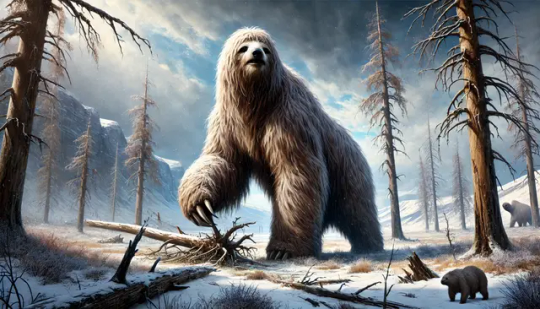
The Giant Ground Sloth: A Colossus of the Ice Age
The giant ground sloth (Megatherium), one of the largest land mammals to roam the Earth, was a true marvel of the Pleistocene epoch. These massive herbivores could reach heights of up to 20 feet when standing upright and weighed as much as 4 tons. Their slow movements belied their immense strength, which they used to strip trees of leaves and bark, shaping the vegetation of their ecosystems.
Covered in thick fur, the giant ground sloth was well-adapted to the cooler climates of the Ice Age. It had massive claws that, while primarily used for foraging, could also serve as formidable defensive weapons against predators like saber-toothed cats and short-faced bears.
Native to South and Central America, giant ground sloths lived in forests and grasslands, where they played a vital role in seed dispersal and vegetation management. Despite their size and adaptations, they faced extinction around 10,000 years ago, likely due to climate change and human hunting. Today, their fossils stand as a testament to the grandeur and diversity of Ice Age megafauna.
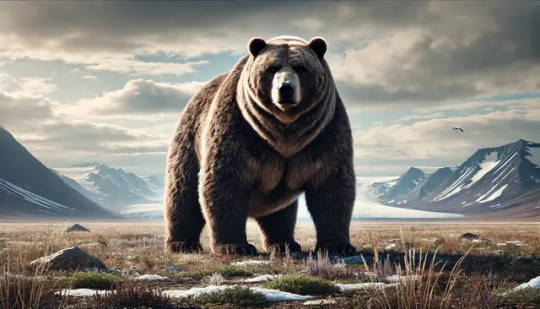
The Short-Faced Bear: Apex Predator of the Ice Age
The short-faced bear (Arctodus simus), a colossal carnivore of the Pleistocene epoch, was among the largest terrestrial predators to ever roam North America. Standing up to 6 feet tall at the shoulder on all fours and towering over 12 feet when upright, this formidable creature could weigh over 2,000 pounds. Its long limbs and muscular build made it surprisingly agile, capable of running at speeds of up to 40 miles per hour.
Known for its dominance, the short-faced bear likely employed a mix of scavenging and predation to secure food, using its immense size to intimidate other predators and claim their kills. Its wide muzzle and sharp claws further reinforced its apex status, enabling it to take down large prey like mammoths and bison.
Adapted to the harsh climates of the Ice Age, the short-faced bear thrived in open plains and tundra but eventually faced extinction around 11,000 years ago, possibly due to environmental changes and competition with humans. Despite its demise, this towering predator remains an iconic symbol of Ice Age megafauna.
The Mission in Action
“This storm’s instability is beyond predicted parameters,” Anika muttered, reviewing data streaming from the Temporal Environmental Stabilizer (TES). The portable device emitted faint pulses, struggling to calibrate against the temporal anomalies.
“Define ‘beyond predicted,’” Gunnar said, shielding his eyes as a herd of mammoths phased into existence before vanishing moments later. “Because I’m pretty sure that’s not normal.”
“The epicenter is approximately two kilometers south,” Cairn, the team’s AI interface, announced through their comms. “It aligns with a critical migratory path for early Homo sapiens and their interactions with Denisovans. Disruption here risks cascading effects on their dispersal and subsequent evolution.”
Karim looked up sharply from his holographic map. “Early Homo sapiens were at a pivotal point during this epoch. Their migration through this region shaped the genetic diversity and adaptive strategies that defined modern humans. Disrupting this could prevent the development of agriculture, written language, and even advanced societies.”
“If this storm isolates their migration, the anthropological timeline could collapse,” Karim added. “We might not even exist to fix it.”
Climactic Challenges
Braving the relentless storm, the team advanced toward the epicenter. Their progress was slowed by fluctuating environmental conditions as patches of ice transformed into treacherous mud underfoot. Nearing the core, they encountered two distinct groups of hominins—Neanderthals and a smaller, darker-featured group that Anika identified as Denisovans. Both groups seemed alarmed by the storm, their survival instincts driving them toward higher ground.
“These people aren’t just isolated relics,” Karim said softly. “They’re part of the story of us all.”
Cairn’s voice chimed in. “Denisovan genetic contributions, particularly the EPAS1 gene, were critical for human survival in high-altitude regions. Without it, modern Tibetans and other highland populations might lack the adaptations needed to thrive in low-oxygen environments, jeopardizing their survival and the broader trajectory of human evolution.” As noted by Huerta-Sánchez et al. (2014), this gene, inherited through Denisovan introgression, is pivotal in facilitating human habitation of extreme altitudes.
Anika adjusted her scanner. “This isn’t just about survival—it’s about the advantages that allowed humanity to spread and adapt.”
A Moment of Triumph
The debate was cut short as the storm intensified, seismic activity disrupting the frozen terrain. Temporal anomalies materialized around them—predatory megafauna blinked into existence, their roars distorted by temporal echoes.
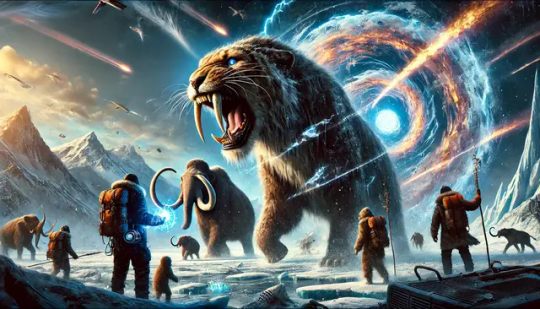
A saber-toothed cat materialized mere meters away, its massive fangs glinting as it snarled. Gunnar stepped forward, weapon in hand. “I’ll handle this. Keep stabilizing the storm.”
Moments later, the shadow of a woolly mammoth emerged, its massive frame shaking the ground. Karim paused to observe it in awe. “These creatures shaped this ecosystem. It’s incredible to see them in their prime.”
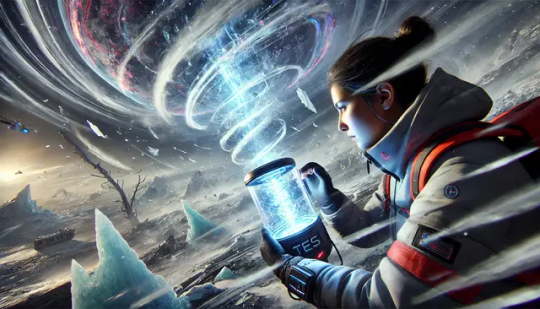
Dr Anika adjusting the Temporal Environmental Stabilizer (TES) amidst a chaotic temporal storm, emphasizing her effort to stabilize the anomalies
Anika activated the TES, monitoring its diagnostic outputs as she calibrated the device to match the storm’s oscillation patterns. Meanwhile, Karim extended rudimentary shelters to shield both groups of hominins from the worst of the storm’s chaos.
The TES emitted a deep, resonant hum, accompanied by a pulsing glow that illuminated the chaotic tundra. Waves of shimmering energy radiated outward, stabilizing the swirling temporal storm. The air crackled with static, and faint echoes of distorted time faded into silence as glaciers ceased their erratic transformations. The glacial landscape steadied, its temporal anomalies dissipating as the device reached its full capacity. The Neanderthals and Denisovans watched in quiet awe as the team vanished, their fleeting presence leaving behind only faintly etched memories.
Scientific References:
These references provide a scientific foundation for the narrative, linking the story's fictional elements to real-world research. They highlight the genetic, ecological, and evolutionary contexts of Homo sapiens, Neanderthals, and Denisovans, underscoring the importance of genetic exchanges and environmental adaptations described in the story. For instance, studies on the EPAS1 gene illuminate its critical role in altitude adaptation, while research on megafaunal extinctions helps frame the ecological challenges of the Ice Age.
Green, R. E., Krause, J., Briggs, A. W., et al. (2010). A draft sequence of the Neandertal genome. Science, 328(5979), 710-722.
Meyer, M., Kircher, M., Gansauge, M. T., et al. (2012). A high-coverage genome sequence from an archaic Denisovan individual. Science, 338(6104), 222-226.
Huerta-Sánchez, E., Jin, X., Asan, et al. (2014). Altitude adaptation in Tibetans caused by introgression of Denisovan-like DNA. Nature, 512(7513), 194-197.
Koch, P. L., & Barnosky, A. D. (2006). Late Quaternary extinctions: State of the debate. Annual Review of Ecology, Evolution, and Systematics, 37, 215-250.
MacPhee, R. D. E., & Marx, P. A. (1997). The 40,000-year plague: Humans, hyperdisease, and first-contact extinctions. Natural History, 106(10), 50-55.
Stuart, A. J. (1999). Late Pleistocene megafaunal extinctions: A European perspective. New Zealand Journal of Zoology, 26(4), 361-372.
Quiz: Understanding Chronostorm Adventure: The Ice Age Gambit
Multiple Choice Questions
What was the primary reason for the team's jump into the Ice Age? a) To study megafauna. b) To stabilize a temporal storm threatening human evolution. c) To gather artifacts from the Pleistocene epoch. d) To observe Denisovans in their natural habitat.
Which gene, inherited from Denisovans, is critical for survival in high-altitude environments? a) FOXP2. b) EPAS1. c) CCR5. d) BRCA1.
What role does the Temporal Environmental Stabilizer (TES) play in the story? a) It helps the team communicate across time. b) It stabilizes temporal anomalies and anchors timelines. c) It allows the team to control megafauna. d) It generates energy for survival in the Ice Age.
What were the two hominin groups the team encountered during the mission? a) Homo erectus and Denisovans. b) Neanderthals and Homo habilis. c) Neanderthals and Denisovans. d) Homo sapiens and Australopithecus.
What major challenge did the team face upon reaching the Ice Age environment? a) Defending against aggressive Neanderthals. b) Stabilizing the storm while navigating unstable terrain. c) Running out of resources for survival. d) Losing communication with Cairn, the AI.
Short Answer Questions
Why was the EPAS1 gene significant to the story's stakes?
How did the Pleistocene epoch's environmental conditions impact the mission?
What challenges did the team encounter during their journey to the storm's epicenter?
Describe the role of Cairn, the AI, in assisting the team.
What was the significance of stabilizing the storm for human evolution?
Hitchhiker’s Guide Disclaimer for the Exclusive Interview with Dr. Anika
Attention, Earthlings and Temporal Wanderers: The following interview with Dr. Anika, esteemed mission lead of Chronostorm Adventure: The Ice Age Gambit, is for entertainment and speculative purposes only. Any resemblance to actual missions, time-travel protocols, or Pleistocene events is purely coincidental—unless, of course, you’ve been to the Ice Age, in which case, welcome back!
Scientific Veracity Advisory: While Dr. Anika’s remarks on genetic contributions and megafauna are grounded in speculative science and vivid imagination, it is strongly advised not to disturb your local geneticist with requests for Denisovan-inspired adaptations. Leave the EPAS1 gene to the professionals.
Megafauna Awareness Notice: If at any point during this interview you feel a deep, inexplicable connection to saber-toothed cats or woolly mammoths, we recommend consulting a professional—preferably one with a background in evolutionary psychology. Feeding extinct creatures is, as always, strongly discouraged.
Final Note: Don’t Panic. Whether you’re braving the swirling winds of a temporal storm or just trying to understand Dr. Anika’s scientific insights, keep calm, bring a towel, and always follow time-travel safety protocols. Unless you want your AI to scold you for destabilizing the timeline.
Now, settle in and enjoy the exclusive interview. And remember: history may be written by the victors, but time travel stories are written for fun.
Exclusive Interview with Dr. Anika, Mission Lead of Chronostorm Adventure: The Ice Age Gambit
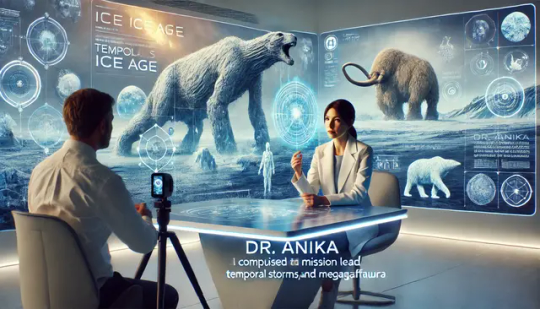
Interviewer: Dr. Anika, thank you for joining us. The mission to the Ice Age was unprecedented. Can you share what motivated the team to undertake such a risky operation?
Dr. Anika: Of course. The detection of the Chronostorm in the Pleistocene epoch was a game-changer. We knew that if left unchecked, it would disrupt critical migratory patterns of early Homo sapiens and their interactions with Denisovans. That kind of disruption wasn’t just about losing a part of history; it risked unraveling the genetic foundations that define modern human adaptability. We had no choice but to act.
Interviewer: The EPAS1 gene seems to have been a focal point of the mission. Why was it so critical?
Dr. Anika: The EPAS1 gene, inherited through Denisovan interbreeding, is crucial for survival in high-altitude environments. It regulates oxygen use by managing red blood cell production. Without it, modern highland populations like those in Tibet might never have adapted to such extreme conditions. Preventing its loss was vital, not just for understanding human evolution but for safeguarding the genetic tools that underpin survival in diverse environments.
Interviewer: Can you describe the moment you first entered the Ice Age?
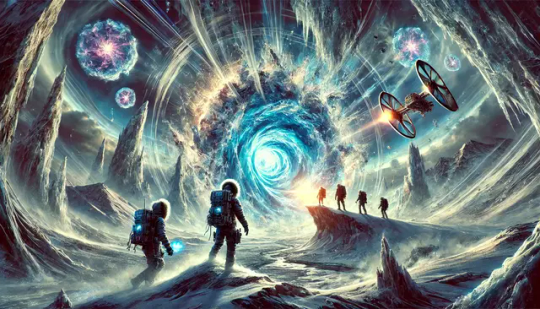
Dr. Anika: It was surreal. The environment was in flux—glaciers forming and dissolving, tundra flickering between states. The swirling temporal storm wasn’t just visual; you could feel the weight of time itself distorting. It was a visceral reminder of how delicate the timeline was and how much we were risking.
Interviewer: What was the most challenging aspect of the mission?
Dr. Anika: Stabilizing the Temporal Environmental Stabilizer (TES) amidst the storm was incredibly demanding. The fluctuating environmental conditions—patches of ice turning to mud, seismic activity—made it hard to maintain precision. On top of that, encountering both megafauna and early hominin groups added layers of complexity. Every decision felt like it had the potential to ripple across history.
Interviewer: Speaking of hominins, what was it like to encounter Neanderthals and Denisovans?
Dr. Anika: Humbling, to say the least. Seeing them in their natural context brought history to life. They weren’t just relics of the past—they were thriving, adaptive people. It reminded us that their contributions to our genetic and cultural heritage run deep. Interacting with them, even indirectly, reinforced the stakes of our mission.
Interviewer: Gunnar had a particularly tense moment with the saber-toothed cat. How did the team handle the dangers posed by megafauna?
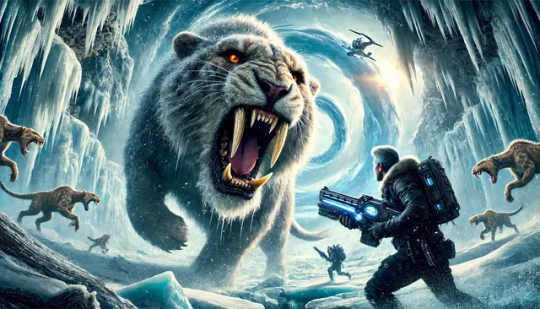
Dr. Anika: Gunnar’s quick thinking and bravery were instrumental in keeping us safe. We went in prepared for encounters, but there’s only so much you can do when facing an apex predator like a saber-toothed cat. Maintaining focus on the TES while managing immediate threats required constant coordination and trust in each other’s expertise.
Interviewer: After stabilizing the storm, how did it feel to leave the Ice Age?
Dr. Anika: Bittersweet. On one hand, we knew we’d succeeded in protecting a crucial chapter of human history. On the other, there was a profound sense of loss knowing we’d only touched the surface of their world. The Neanderthals and Denisovans we saw will stay with us forever, etched in memory.
Interviewer: What lessons do you hope humanity takes from this mission?
Dr. Anika: That our past is not just a story to be remembered—it’s a foundation that shapes who we are and who we can become. The genetic exchanges, the adaptations, the resilience—it’s all a testament to the interconnectedness of life. Protecting and understanding that history is not just an academic pursuit; it’s a responsibility.
Interviewer: Dr. Anika, thank you for sharing your insights. It’s been an honor.
Dr. Anika: The honor is mine. Thank you for giving us the space to reflect on the mission.
#climate adventure#time travel#science fiction#make science fun again#learn about history#learn about evolution
0 notes
Text
I HATE THE CARCINISATION MEME THING, IT'S NOT SOME KIND OF UNIVERSAL BIOLOGICAL LAW THAT HAPPENS TO ALL ANIMALS, IT ONLY HAPPENS IN SOME SELECT GROUPS OF CRUSTACEANS (THAT ARE CLOSELY RELATED TO CRABS ANYWAYS), THERE ARE MORE INTERESTING EXAMPLES OF CONVERGENT EVOLUTION TO DISCUSS, AND IT'S JUST NOT FUNNY. WE DON'T TALK ABOUT ALL THE EXAMPLES OF FILTER FEEDERS OR WORM LIKE CREATURES LIKE THAT DO WE. IT'S BECAUSE SOME BRITISH GUY MADE A STUPID JOKE AND EVERYONE RAN WITH IT.
LANCELOT ALEXANDER BORRADAILE YOU HAVE NO IDEA THE HARM YOU HAVE CAUSED ME PERSONALLY.
#cosas mias#just stop with the stupid crab joke it's not funny#go learn about convergent evolution if you're interested
903 notes
·
View notes
Note
He was nervous and he wasn’t sure why. Eleanor had been in Alfred’s care for a few days, she was probably fine, but…well, he missed her. Missed working with her and just hanging out. So he sent a text.
📱: how’re you feeling?
[Eleanor: sore. And incredibly bored. Also, bones grow itchy while they heal. horrible feeling. I have complaints to register with evolution.]
#//the complaints with evolution thing is something I have said in real life#//as well as threatening to raise complaints with God and mother nature#//this is what happens when I learn about the human skeletal system
90 notes
·
View notes
Text

oh shit metal stole tails' speak & spell
#sonic the hedgehog#sth#metal sonic#sonic fanart#miles tails prower#ive done nothing but draw metal for like a week straight.#idk man something about him!! can't stop thinking about this robot#ok so technically this is a part of the story that lives in my head where belle and metal keep running into each other#and every time they meet metal has developed a new way to express himself#starting w writing in the dirt. then he steals the speak and spell. then he starts to learn a form of sign language#bc i think communication is an element that's really important to metal's evolution as a character#like. there must be a reason why metal gave himself a voice the one time he tried to evolve past eggman as neo#idk. many thoughts but not enough coherent words to articulate.#robot :)#art#my art#weaverofink
185 notes
·
View notes
Text

I love X-Men Evo but this Charles Xavier was the worst Charles Xavier ever.
#x-men evolution#the way he had NO interest in Toad but he let Avalanche come around a couple times...#the way he either didn't know of the Morlocks or just straight-up didn't care about them...#like. this guy was literally picking and choosing only the most photogenic mutants he could collect for his teen army#kurt gets an image inducer immediately (bc kurt has useful powers!) but todd doesn't.#they don't try very hard to collect Avalanche when they meet him either. they don't try very hard to help Blob when they meet him#I KNOW they're introducing X-Men to kids so they had to truncate the story. I KNOW!!!#but they sure made Xavier look like a very calculating asshole. he apparently goes to see Wanda every now and then but he helps#keep her locked up in the mental hospital/prison? so much for ''come to my school and learn to deal with your powers'' :\
110 notes
·
View notes
Text

#poliwhirl#i feel like i need a new angle type for this. looming??#we'll call it a#muncher#for now. anyway this motherfucker i remember for being in the one episode of anipoké that i caught like Half a glimpse of#where i think ash learned about evolution stones and he was trynna make pikachu evolve or some shit. and they used this guy#as an example for a water stone. and i swear that's where i got the idea in my head that#1. you can use the stones on any pokémon you want as long as it matches their type (false‚ made up)#2. the pokémon do not Like it when you use the stones on them to make them evolve sooner than they should (probably spurred by#pikachu obviously not wanting to evolve and my brain thought that applied to every pokémon ever)#obviously i don't believe these things anymore. i know how evolution stones work. but i believed them when i was a kid#and was very confused when i couldn't evolve prinplup using a water stone
157 notes
·
View notes
Note
Random evo thought:
Do you think they ever told William that Aelita and Odd weren't actual cousins?
William: Sorry about your uncle, Odd
Odd: Wut?
omg right 😭 there's so much he'd need to be caught up on, why would they pass up on that comedic potential

#ask aqof#ani-action#code lyoko#code lyoko evolution#//his arms got smaller as he kept learning things and getting more unhinged idk don't worry about it#william dunbar#//cle writers: we'll need someone new on the team to help explain things for anyone new to cl. guess we'll have to create a brand new chara#//also them: whee let's plonk this secondary character onto the main cast as if he's been there all along & knows everything somehow#//storywriting!!!!!!!!!
50 notes
·
View notes
Text
here is another silly thing about alphinaud. is that he loves to Get information he’s like a little information magpie but as soon as he gets it he latches onto it for the next several days to weeks. he finds out that spending money is something you need to be careful about he’s going to bring it up and be extra frugal every time he buys something for a week. he learns how to collect firewood he’s going to volunteer for it as if he is already very good at it and knows a lot about it. alphinaud is the kind of person to learn a fun relevant fact about birds and tell you, as soon as it comes up, this fun fact about birds that he’s been dying to tell someone for hours. someone let him infodump about social policy
#play game#ffxiv#I think it’s partly he wants to never be the dumbest person in the room but also he’s just very excited about Learning#he has straight a student syndrome he needs to demonstrate that he learned to do something correctly#And hes also just so intensely interested in how things work he’ll read a 500 page manual. Which is canon#wow!!! did you know (obscure bird) looks exactly like (other obscure bird) but they’re unrelated they just went thru convergent evolution!!#this is important because one is peaceful and one breathes fire (ARI DODGES)
424 notes
·
View notes
Text
demons in sousou no frieren:
we do not understand human emotions, we do not feel them, to us it's all a game and even when we try it will inevitably lead to death, destruction and human suffering
also demons in sousou no frieren:
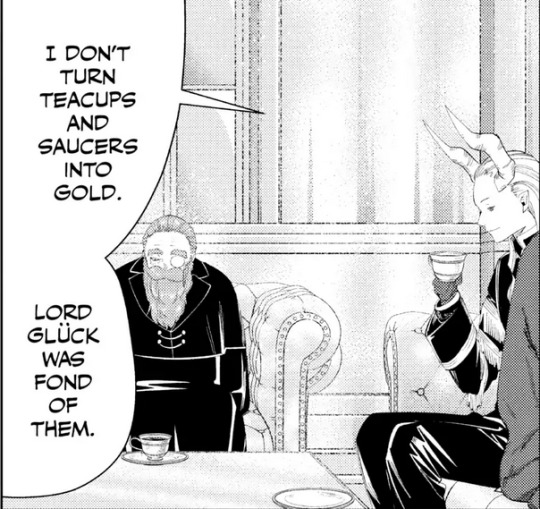
#the old man yaoi game is exquisite i was genuinely not expecting this goddamn#sousou no frieren#frieren: beyond journey's end#frieren at the funeral#macht of the golden land#lord gluck#mind you#the two statements aren't mutually exclusive#i'm excited to learn more about how and why demons live#that convergent evolution thing will probably come back#because usually convergent species might compete for resources#but they don't feed off each other#rather solve the same problem with similar solutions
103 notes
·
View notes
Text
Wondering how Hellenic Polytheism will look in the future. Not just in a couple of decades, I mean like 10,000+ years later.
Will it still be practiced? Will humans still be Homo sapiens? What will future humans think of us? What about flora and fauna that may not exist anymore? Will they see how we practiced and find the descendants/closest relatives of today's animals? Will certain gods be more popular? Will they read the Odyssey and think about the long journey because they can just go through a tunnel and reach their destination in minutes? Will they look at maps and compare locations?
#Don't mind me#I'm taking a small course on dinosaurs and have been learning about the natural history of this world and human evolution#Probably giving myself an existential crisis too#witchblr#paganblr#witchcraft#deity work#deity worship#helpol#hellenic polytheism#hellenic pagan#hellenic paganism#hellenic gods#hellenic deities#hellenic worship
26 notes
·
View notes
Text
Like I get that there are disparities in the US between different quality of education in different regions but come the fuck on. It's Not the job of the education system to teach you literally Everything you should know as an adult human. At some point you gotta take responsibility for your own knowledge. Take the little rectangle that contains the wealth of human knowledge you keep in your pocket and go on wikipedia and look at a list of the most populated cities in the world, as a start. You're allowed to not know everything about everything but don't blame others for your own ignorance my god.
#like my high school deliberately didnt teach us about evolution. i didnt then go oh ok i guess i dont need to learn about evolution 👍. i#went to the damn library and read a book about evolution
79 notes
·
View notes
Text

the evolution of luke hughes cellies:
flick! vs niagara university 11.26.21
#learn your lore#as requested on main here is the new 'learn your lore' series#i noticed recently that a lot of people simply don't know where to start when asking about older umich history#or are reporting kinda inaccurate information about things#so here to help educate yk!#give people a place to start#not all will be gif series but this one will be#and there's a ton so stay tuned!#evolution of luke hughes cellies#gifs#luke hughes#umich hockey#brendan brisson#jacob truscott#mark estapa#matty beniers#2021 22 season
39 notes
·
View notes
Text
I love when characters are introduced in adaptations and then brought into comics. It’s like “Yeah, I know you made this character for your canon, but we wanna play with them too.”
#fun fact this post was inspired when I learned about X-23 starting out in X-Men Evolution#revelations and stupidity
13 notes
·
View notes
Text
Daily fish fact #685
Lampreys!

While some lampreys turn to a parasitic lifestyle as adults, drilling into the sides of bigger animals to feed on their flesh and blood, lamprey larvae, ammocoetes, are actually filter feeders! The lamprey larva life stage can last up to a decade, and they spend their time being half-buried in sandy substrate, consuming whatever tiny organic particles float to them. Ammocoetes' feeding rate is the slowest of any suspension-feeding animal, and due to this they require a habitat very rich in nutrients.
#i might as well use that information i researched about lampreys to make that one propaganda post to some good use!#and... woah. lampreys are so cool? they dont have eyes as larvae so when they metamorphose they literally gain the ability to see images.#imagine! youve gone your whole life only sensing light but then you metamorhose and you gain eyes and teeth and can start swimming#how does that feel? are they... surprised? i bet the ones that travel to saltwater experience things they never thought they would#of course im putting my own human emotions on them but... okay. just imagine how crazy it would be!?#their filter feeding apparatus becomes a thyroid gland too!!?!?? thats so insane!!!!! what wonderful animals i cant believe im only now -#learning of this!!!!! like their body transformation can tell us about vertebrate evolution!!!!#lamprey#fish#fishfact#fish facts#biology#zoology#fishblr
114 notes
·
View notes
Text
Headcanon of the day is that Fairies tend to LOVE bugs. Specifically bugs like beetles or bees, because they share a similar wing shape! "Bug" is a common affectionate name for Fairies' partners or children, and parents tend to coo phrases like "my adorable little insect". Bugs are treasured creatures, and there's probably a dozen little superstitions relating to how seeing a certain bug in your house brings good luck.
This also happens to fit in with Anti-Fairies, who have bat-like wings and use "bat" as an affectionate nickname. Encouraging Anti-Fairy children to hate their counterparts tends to go something along the lines of "you'll hunt them down, just like the bats of the wild do to bugs!"
They look like bats for a reason, they'll say, and maybe it's partially true! Perhaps they co-evolved just like bats and moths did, evolved to hunt down their 'prey' with efficiency. Ideally. Unfortunately all of them are kinda stupid in one way or another </3
#sorry. guy who likes bugs voice#guy who specifically loves moths voice and has researched them enough to learn about bats and moths co-evolution voice#i <3 bugs#i wish more ppl liked bugs#so i will make the Fairies as a species like bugs#fairly oddparents#fop
51 notes
·
View notes